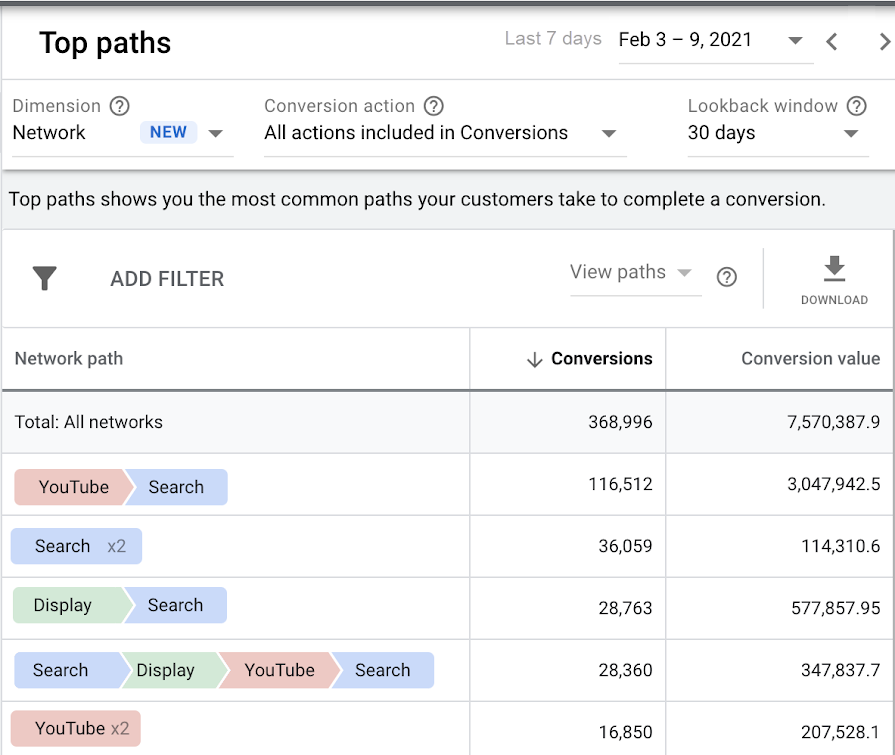Google Ads analytics data is packed with insights that can help you understand the performance of your campaigns and make data-driven decisions.
But for many marketers, it can be challenging to know which metrics to focus on and how to interpret the data. In this blog, we break down the key metrics and reports you need to know. Plus, we share how to extract actionable insights from Google Ads analytics, with a special look at the latest updates from Google Analytics 4 (GA4).
Sections
Focus on key Google Ads performance metrics
When analyzing your Google Ads performance, it’s crucial to focus on metrics that directly impact your business goals. Here are the key metrics to prioritize.
- Click-through rate (CTR): This measures how often people who see your ad actually click on it. A high CTR suggests that your ad is relevant and compelling to your audience. If your CTR is low, consider revisiting your ad copy, keywords, or targeting.
- Conversion rate (CVR): The conversion rate tracks the percentage of clicks that result in a desired action, such as a purchase or lead form submission. If your CVR is low, it may signal that your landing page needs optimization, or that your ad copy is overselling what you’re actually offering.
- Cost per click (CPC): This metric reflects how much you’re paying for each click on your ads. Monitoring CPC helps you balance your ad spend, ensuring that you’re getting a good return on investment (ROI).
- Cost per acquisition (CPA): CPA measures the cost to acquire a new customer or lead. By keeping an eye on your CPA, you can determine if your campaign is profitable and make adjustments to increase efficiency.
Use Google Ads reporting tools effectively
Google Ads offers several built-in reporting tools to help you slice and dice your data in different ways. Here are some of the most useful ones.
- Campaign reports: These reports provide an overview of all your campaigns and their key performance metrics. You can use this data to compare how each campaign is performing and identify which strategies are delivering the best results.
- Search terms report: One of the most powerful tools in your Google Ads toolkit, the search terms report shows you exactly what users were searching for when they clicked on your ad. This data can help you refine your keyword list, add negative keywords, and better match your ads to high-intent searches.
- Auction insights: The auction insights report allows you to see how your ads stack up against your competitors in the same auctions. You’ll gain valuable insights into where you may need to increase your bids or improve your quality score to stay competitive.
- Attribution reports: Google Ads attribution reports help you understand how different touchpoints across the customer journey are contributing to conversions. By analyzing attribution data, you can optimize your campaigns for a higher ROI by identifying the most effective customer touchpoints.

Extract actionable insights from Google Ads analytics
Analyzing Google Ads data is not just about looking at numbers. It’s about using those numbers to make smarter decisions. Here are some ways to extract actionable insights from your Google Ads analytics.
- Identify high-performing keywords: Look for keywords with high conversion rates and a low CPA, and consider increasing bids or budget allocation for those terms. You might also consider reducing bids or pausing keywords that are underperforming.
- Optimize your ad copy: A/B testing different versions of your ad copy can reveal which messaging resonates best with your audience. Review ads with higher CTRs and conversions and identify patterns in the wording, offers, or calls to action.
- Adjust targeting: If certain geographic locations or devices are performing better than others, shift more of your budget towards these segments. You can also evaluate audience segments to see where you can increase engagement and conversions.
- Monitor your quality score: Your ad’s quality score impacts your ad rank and CPC. Boost your quality score by refining your landing pages, reworking your ad copy, and improving your keyword relevance.
How GA4’s new features enhance Google Ads analysis
Google Analytics 4 (GA4) offers powerful new tools for understanding user behavior and enhancing your Google Ads performance. Here’s a quick overview of key features that you should be using.
- Event-based tracking: GA4 moves away from the session-based tracking model of Universal Analytics to event-based tracking, which gives a more granular view of user interactions with your ads and website. You can track every click, form submission, and engagement, giving you richer data to analyze.
- Enhanced cross-device reporting: With GA4, you can better understand how users interact with your ads across devices and channels. This helps you see the full customer journey and optimize your campaigns to capture conversions across multiple touchpoints.
- AI-powered insights: GA4 uses machine learning to automatically generate insights and forecasts based on your data. You’ll receive suggestions for which campaigns need adjustments and where there are opportunities to improve performance.
Are you ready to make the most of your Google Ads data? Contact Your Marketing People today for a personalized review of your campaigns. We’ll help you interpret your analytics data and fine-tune your campaigns for stronger results.







